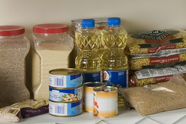PETE Bottles For Longer-Term Storage
Bottles made of PETE (polyethylene terephthalate) plastic can be used with oxygen absorbers to store products such as wheat, corn, and dry beans. PETE bottles are identified on the container with the letters PETE or PET under the recycle symbol.
Other types of plastic bottles typically do not provide an adequate moisture or oxygen barrier for use with oxygen absorbers. Do not use containers that were previously used to store nonfood items.
PETE bottles can also be used for shorter-term storage (up to 5 years) of other shelf-stable dry foods such as white rice.
Moisture content of stored foods should be about 10 percent or less. When moist products are stored in reduced oxygen packaging, botulism poisoning may occur.
Packaging in PETE Bottles
- Use PETE bottles that have screw-on lids with plastic or rubber lid seals. You can verify that the lid seal will not leak by placing a sealed empty bottle under water and pressing on it. If you see bubbles escape from the bottle, it will leak.
- Clean used bottles with dish soap, and rinse them thoroughly to remove any residue. Drain out the water, and allow the bottles to dry completely before you use them for packaging food products.
- Place an oxygen absorber in each bottle. The absorbers can be used with containers of up to one-gallon capacity (4 liters).
- Fill bottles with wheat, corn, or dry beans.
- Wipe top sealing edge of each bottle clean with a dry cloth and screw lid on tightly.
- Store the products in a cool, dry location, away from light.
- Protect the stored products from rodents.
- Use a new oxygen absorber each time you refill a bottle for storage.
Where to Get Oxygen Absorber Packets
Oxygen absorber packets are available at home storage centers and Church Distribution Services, or they can be ordered online at store.lds.org. Unused oxygen absorbers can be stored in glass jars with metal lids that have gaskets.
Oxygen Absorbers
Oxygen absorbers protect dry foods from insect damage and help preserve product quality. They are used when dry foods are packaged in sealed containers. Oxygen absorbers can be purchased from home storage centers and Church Distribution Services, or they can be ordered from
store.lds.org.
What are oxygen absorbers made of?
Oxygen absorbers are small packets that contain an iron powder. The packets are made of a material that allows oxygen and moisture to enter but does not allow the iron powder to leak out.
How do oxygen absorbers work?
Moisture in the packaged food causes the iron in the oxygen absorber to rust. As it oxidizes, the iron absorbs oxygen. Oxygen absorbers rated for 300 cubic centimeters (cc) of oxygen work well for properly packaged dry food in containers of up to one-gallon capacity (4 liters).
Is the use of oxygen absorbers equivalent to vacuum packaging?
Oxygen absorbers remove oxygen more effectively than vacuum packaging. Air is about 20 percent oxygen and 80 percent nitrogen. Absorbers remove only the oxygen. The air left in the container is mostly nitrogen and will not affect the food or allow the growth of insects.
What types of products can be stored using oxygen absorbers?
Products should be low in moisture and oil content. If the moisture content is not low enough (about 10 percent or less), storing products in reduced oxygen packaging may result in botulism poisoning.
What types of containers can be used with oxygen absorbers for food storage?
Oxygen absorbers should be used with containers that provide an effective barrier against moisture and oxygen. The following containers work well:
Metal cans with seamed lids.
Foil pouches (such as those provided by Church home storage centers and available from
store.lds.org).
PETE plastic bottles with airtight, screw-on lids.
Glass canning jars with metal lids that have gaskets.
Oxygen absorbers are not an effective treatment method for plastic buckets, milk bottles, or other types of plastic bottles not identified as PETE or PET under the recycle symbol (see right).
What is the proper way to use oxygen absorbers?
- Cut open the top of the bag of absorbers. Do not open the individual absorber packets.
- Remove the number of absorbers from the bag that you will use in the next 20 to 30 minutes, and spread them out on a tray. Remove additional groups of absorbers from the supply as you need them during the packaging process, but do not open and close the bag repeatedly to get only a few absorbers at a time.
- Reseal the remaining supply of absorbers by one of the following methods. Do not store absorbers in ziplock bags.
- Seal the bag of absorbers with the special blue clamp provided by the home storage center.
- Seal the bag of absorbers with an impulse heat sealer.
- For longer storage when an impulse sealer is not available, remove the absorbers from the bag and place them into a glass canning jar that has a metal lid with a gasket. A one-pint jar (500 ml) will hold 25 absorbers.
- Place one absorber into each container of food as it is packaged.
https://www.lds.org/topics/food-storage/longer-term-food-supply?lang=eng#1
